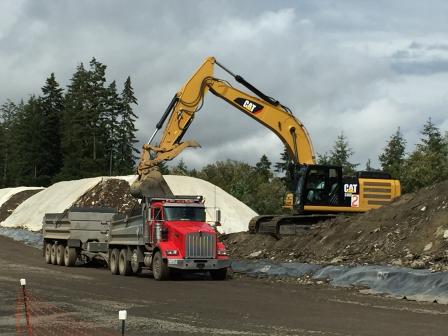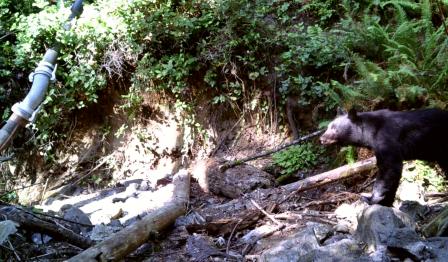News Releases from Region 10
EPA, Navy, Suquamish Tribe, Washington Department of Fish and Wildlife, and Kitsap County Celebrate Bremerton Landfill–Gorst Creek Cleanup and Restoration

This week, the U.S. Environmental Protection Agency, the U.S. Navy, the Suquamish Tribe, Washington Department of Fish and Wildlife, Kitsap County and Kitsap Public Health District are celebrating the completion of an extensive multi-year cleanup of the Bremerton Landfill—Gorst Creek cleanup site. Located on Highway 3, in Bremerton, Washington, the cleanup site is about five miles upstream from Sinclair Inlet and Puget Sound.
The EPA and its partners completed the excavation and removal of nearly 340,000 tons of debris and hazardous materials from the six-acre 1950s-era landfill, which will prevent further downstream toxic pollution from moving downstream, and protect water quality for people, fish and other wildlife. As part of the landfill removal, EPA restored over 1,000 feet of Gorst Creek, a fish-bearing stream, which had been buried under the landfill for over 50 years.
“We’re very proud to celebrate a successful completion of this major cleanup effort that will protect community health and our environment,” said EPA Region 10 Deputy Regional Administrator Michelle Pirzadeh. “With our partners the U.S. Navy, the Suquamish Tribe, state and local agencies, we accomplished a significant cleanup and helped restore Gorst Creek, vital and much needed habitat for fish and wildlife in the Puget Sound watershed.”
“We are happy to see one of our state's great natural resources restored,” said Rear Adm. Gary Mayes, commander, Navy Region Northwest. “One of the greatest things I have witnessed in my time here has been our partnerships in action and this restoration is a prime example of what can be done when community partners come together with a common goal.”
“The removal of the Gorst landfill is a great accomplishment. It improves habitat for endangered native salmon and shows how we can right the errors of our past. This project demonstrates how all of us can turn the tide for the future of this sacred resource and improve the health of the environment for generations to come,” said Leonard Forsman, Chairman of the Suquamish Tribe.
In a 2016 settlement with the EPA, the Navy agreed to fund the removal and cleanup of the landfill and restoration of Gorst Creek, estimated to cost nearly $30 million. Beginning in the 1950s, the landfill collected auto wrecking and demolition debris, household and industrial waste, scrap metal and other junk. The landfill also accepted demolition materials and trash from the Puget Sound Naval Shipyard. When the landfill was constructed, Gorst Creek was diverted into a culvert beneath the landfill. Over time, as the garbage piled up over 60-80 feet deep in some locations, the landfill crushed the culvert, blocking fish passage to upstream habitat.
During heavy rains, the landfill was inundated and flooded, with the potential to discharge toxic chemicals and heavy metals downstream and into Sinclair inlet and Puget Sound. Frequent storm flows and debris slides from the landfill also covered about 800 yards of the creek bed downstream, degrading and polluting water quality and fish habitat. The Washington State Department of Transportation had to frequently unclog the culvert under Highway 3 when the buildup of trash and heavy rainfall threatened to wash out the highway. The City of Bremerton regularly had to clear garbage from the downstream creek on city property.
EPA’s excavation of the landfill completely removed and safely disposed or recycled nearly 340,000 tons of trash, debris and hazardous materials, transported off-site in more than 10,000 truckloads.
- Over 100 tons of granite were recovered from the landfill and donated to Bremerton, Poulsbo and Kitsap parks departments and Olympic College to re-use as benches and other outdoor features.
- Nearly 900 tons of scrap metal, tires and concrete were recovered for commercial re-use or recycling.
- Native trees and shrubs cleared from the site during construction were saved and re-used for erosion control and stream habitat.
- Almost 4,000 tons of hazardous materials were safely disposed of at permitted disposal facilities.
Following the landfill excavation, EPA restored over 1,000 feet of the Gorst Creek stream channel and restored the natural habitat with over 7,500 native plants. The stream restoration was planned with support and coordination with the Suquamish Tribe, Washington Department of Fish and Wildlife, Washington State Department of Transportation, Kitsap County and Kitsap Health District.
EPA will monitor the cleanup and restoration site for two more years to make sure that the native plants thrive and to control non-native and invasive species.
Bremerton Landfill—Gorst Creek site information, photos and video: Bremerton Landfill–Gorst Creek Cleanup.
Learn more about EPA’s Pacific Northwest Region 10 at: EPA Region 10.
Follow EPA Region on Twitter at: @EPAnorthwest and on Facebook at: @eparegion10.
 In 2018, EPA completed the excavation and removal of nearly 340,000 tons of debris and hazardous materials from the six-acre 1950s-era Bremerton landfill.
In 2018, EPA completed the excavation and removal of nearly 340,000 tons of debris and hazardous materials from the six-acre 1950s-era Bremerton landfill.  EPA’s excavation of the Bremerton Landfill completely removed and safely disposed or recycled nearly 340,000 tons of trash, debris and hazardous materials, transported off-site in more than 10,000 truckloads. EPA, 2017
EPA’s excavation of the Bremerton Landfill completely removed and safely disposed or recycled nearly 340,000 tons of trash, debris and hazardous materials, transported off-site in more than 10,000 truckloads. EPA, 2017 Following the landfill excavation, EPA restored over 1,000 feet of the Gorst Creek stream channel and restored the natural habitat for fish and wildlife.
Following the landfill excavation, EPA restored over 1,000 feet of the Gorst Creek stream channel and restored the natural habitat for fish and wildlife.
